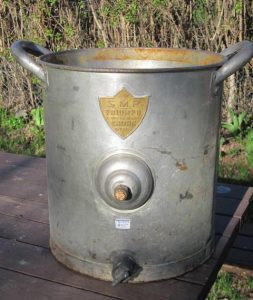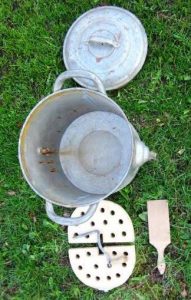Butter-making
 Butter-making used to be a mark of excellent housekeeping for farm women. It requires close attention to sanitation and methodical treatment, from the way the cow is milked to the removal of liquid in the final working of the end product. It is both a science and an art and has been part of human cuisine for millennia. A 3000-year-old block of butter was recently found buried in an Irish peat bog[i] where the cool temperature had preserved it to an extent that it could be recognized.
Butter-making used to be a mark of excellent housekeeping for farm women. It requires close attention to sanitation and methodical treatment, from the way the cow is milked to the removal of liquid in the final working of the end product. It is both a science and an art and has been part of human cuisine for millennia. A 3000-year-old block of butter was recently found buried in an Irish peat bog[i] where the cool temperature had preserved it to an extent that it could be recognized.
The basic principle of butter-making is to agitate cream so that the fat coalesces (or forms into lumps) and separates from the milk, which is then drained off, and the butter rinsed with water to prevent it from going rancid. Butter recipes were popular in early newspapers (see the BCFHN blog post on the first known newspaper recipe in BC).
The first step in making butter is to get a cow. Or failing that, fresh cows’ milk, preferably from a Guernsey or Jersey breed which contains up to 5 % butterfat. (Yak milk is even higher in butterfat content and yak butter tea is an integral part of Tibetan culture[ii]. Then the milk and cream must be separated. The expression “cream rises to the top” is useful to remember. Also “crème de la crème” (thanks to Miss Jean Brody) and “skimming the cream off the top” (thanks to any number of corrupt people who have taken more than their share of resources). See a recent BC Food History blog for information on milk separators.
I interviewed my sister-in-law Rita Milligan about making butter. Her family milked up to 13 cows at a time and this produced lots of butter, in addition to providing cream money. The cans were picked up once a week by either the N.A.D.P. (Northern Alberta Dairy Pool)or Silverwood Dairy, or delivered to the dairy. Everybody had two cream cans; one for shipping and one for collecting.
Cream had to be kept cool until there was enough to churn, or until it was picked up. In the old days a well was often used for refrigeration. Rita remembers lowering the cream can by rope into the well – one time the knot on the rope gave way and she had to climb down to retrieve the can. Lucky, she says, that the well was not very deep.
Ice-cold cream does not make into butter very well. Cream has to “ripen” for the coalescence of the milk fat to begin. Sources vary regarding the optimum temperature to begin agitating the cream with up to five hours at room temperature before churning suggested by some sources. A recent Danish study indicated that half an hour at room temperature is enough. More than that makes little difference in churning time[iii].

Note the dashers (round discs with holes) to agitate the cream. The butter paddle has never been used.
The churning process is simple. Butter can be formed by passing a glass jar of cream (with a tight metal lid) around a kindergarten class and shaken in turn by each student – or any of a variety of butter churns can be used from wood to glass to metal.[iv]
Up to the 1850s, the relationship between cream temperature and success in churning was not clear. A person might churn and churn and butter would never form. Superstitions sprang up about “butter witches” and “cream witches” – women who put “spells” on the milk to prevent butter from forming. After witchcraft was no longer seen as a crime (at least in Britain), cream witches did not take a human form, and remedies were developed for cream that did not churn: one of these was “ to put a red hot horse shoe or a red hot poker into the cream. The cream would boil as the hot metal was put in the churn and people said this was the noise of the witch thrashing about as she was killed. In actuality the temperature of the cream was increased and often this was enough for the butter to start to form”.[v]
When the butter has formed (sometimes so quickly that it seems miraculous) it must be “worked”. Rita describes the process: carefully put the coagulated butter into a sieve and pour off the milk (which can be quite sour depending on how sour the cream has become). Using your hands or a wooden spoon (never metal), move and squeeze the butter to get the milk out. Then wash it in cold water and work it again to get the water out. Finally the butter is shaped into a block and wrapped in butter paper. This is different from parchment paper, more like waxed paper with a silicone coating. Then the butter is put back down the well either literally, or figuratively in a manner of speaking (kept cold by refrigeration or freezing).
In the early days of margarine, the dairy lobby objected to its being coloured to look like butter, and blocks of (white) margarine always came with their own little vials of yellow dye. The lobbyists conveniently forgot that butter also had to be coloured in the winter when the cows were not eating grass.
For a modern approach to butter-making, see Gabe Newman’s presentation on Youtube.
It’s on the Historic O’Keefe Ranch youtube channel, out of Vernon, BC.
[i] https://www.atlasobscura.com/foods/bog-butter-ireland-scotland
[ii] http://www.iyak.org/yak-milk-dairy.html Yaks belong to the same genus as cattle and have possibly been domesticated longer.
[iii] Buldo, P., Kirkensgard & Wilking, L. (2013). Crystallization mechanisms in cream during ripening and initial butter churning. J DairySci, (96), 6782-6791.
[iv] Manjoo, Farhad. (2012). The Hunt for a Better Butter Churn. Slate Magazine. http://www.slate.com/articles/technology/technology/2012/11/butter_churn_technology_how_it_advanced_over_time_and_why_it_didn_t_advance.html
[v] http://www.strangehistory.net/2015/08/29/butter-tricks-and-witches/
